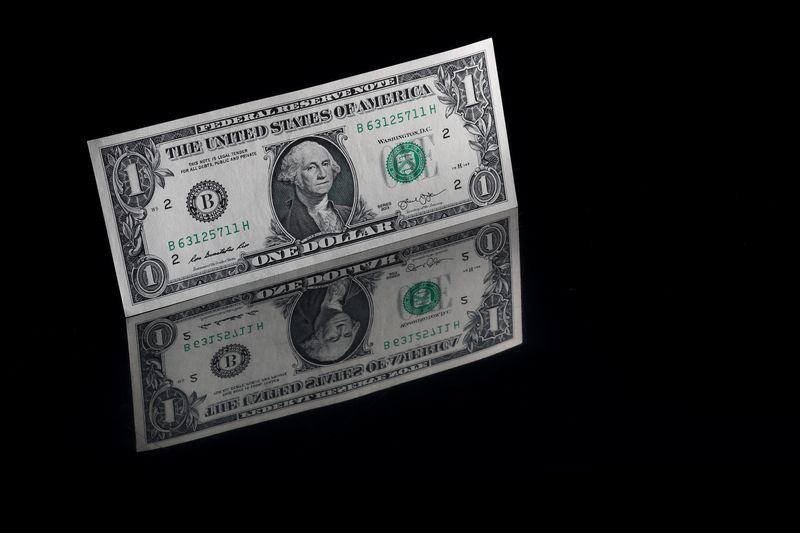 © Reuters. FILE PHOTO: A U.S. one dollar banknote is seen in this illustration taken November 23, 2021. REUTERS/Murad Sezer/Illustration
© Reuters. FILE PHOTO: A U.S. one dollar banknote is seen in this illustration taken November 23, 2021. REUTERS/Murad Sezer/Illustration
By Hannah Lang and Herbert Lash
WASHINGTON (Reuters) -The dollar rose along with other safe-haven assets on Friday after the United States said Russia has massed enough troops near Ukraine to launch a major invasion.
A Russian attack could begin any day and would likely start with an air assault, White House national security adviser Jake Sullivan told a media briefing.
The dollar had been trading mostly sideways when the U.S. warning hit markets. The dollar index, a measure of the greenback against six major currencies, rose 0.258%.
U.S. crude futures jumped more than 5% to $94.66 a barrel, the highest since 2014, while gold rose more than 2% to a near two-month high at one point.
The dollar's rise was due to Sullivan's comments, as well as reports that Russian President Vladimir Putin had decided to invade Ukraine, which the White House later disputed, said Bipan Rai, head of FX strategy at CIBC Capital Markets in Toronto.
That move up, along with moves in other safe-haven assets such as U.S. Treasuries and the Japanese yen, indicates the market is growing more and more concerned about the prospect of an invasion, said Rai.
"It’s definitely a safe-haven move," he said.
The Japanese yen strengthened 0.63% versus the greenback at 115.29 per dollar, while the Canadian dollar weakened as the potential for an imminent Russian attack triggered a sell-off in risk-sensitive assets.
Russia's currency, already lower for the day, fell further on the news. The rouble was last down 2.73% versus the greenback at 77.00 per dollar.
Washington urged all U.S. citizens to leave the country within 48 hours. Other countries -- including Britain, Japan, Latvia, Norway and the Netherlands -- told their citizens to leave Ukraine immediately.
The euro, meanwhile, weakened as markets processed the news, and was set for a weekly decline after European Central Bank President Christine Lagarde said in an interview that raising rates now would not bring down record euro zone inflation but only hurt the economy.
The greenback had struggled to pick a direction earlier in the day as investors digested the University of Michigan’s preliminary consumer sentiment index for February.
That report found that U.S. consumer sentiment fell to its lowest level in more than a decade in early February amid expectations that inflation would continue to rise in the near term. Economists polled by Reuters had forecast the index edging up.
The market's lack of clarity as to how interest rate hikes might progress has contributed to frenzied sessions this week as the dollar remains undecided on the future, said Erik Nelson, a currency strategist at Wells Fargo (NYSE:WFC) Securities.
“I tend to think we consolidate in the short term here and am still biased toward euro downside, dollar upside against most currencies,” he said.
========================================================
Currency bid prices at 3:57PM (2057 GMT)
Description RIC Last U.S. Close Pct Change YTD Pct Change High Bid Low Bid
Previous
Session
Dollar index 96.0390 95.7950 +0.27% 0.393% +96.1180 +95.6380
Euro/Dollar $1.1343 $1.1427 -0.73% -0.22% +$1.1435 +$1.1330
Dollar/Yen 115.2950 116.0000 -0.59% +0.17% +116.1700 +115.0350
Euro/Yen 130.77 132.56 -1.35% +0.35% +132.6100 +130.3900
Dollar/Swiss 0.9250 0.9253 -0.03% +1.40% +0.9287 +0.9236
Sterling/Dollar $1.3554 $1.3561 -0.05% +0.23% +$1.3609 +$1.3515
Dollar/Canadian 1.2741 1.2724 +0.14% +0.78% +1.2753 +1.2670
Aussie/Dollar $0.7134 $0.7169 -0.48% -1.85% +$0.7185 +$0.7109
Euro/Swiss 1.0491 1.0572 -0.77% +1.18% +1.0575 +1.0482
Euro/Sterling 0.8367 0.8426 -0.70% -0.39% +0.8431 +0.8360
NZ Dollar/Dollar $0.6644 $0.6676 -0.43% -2.89% +$0.6693 +$0.6628
Dollar/Norway 8.8680 8.8150 +0.66% +0.72% +8.8870 +8.7925
Euro/Norway 10.0617 10.0600 +0.02% +0.49% +10.0994 +10.0228
Dollar/Sweden 9.3422 9.2904 -0.26% +3.60% +9.3599 +9.2403
Euro/Sweden 10.5976 10.6249 -0.26% +3.55% +10.6437 +10.5370

